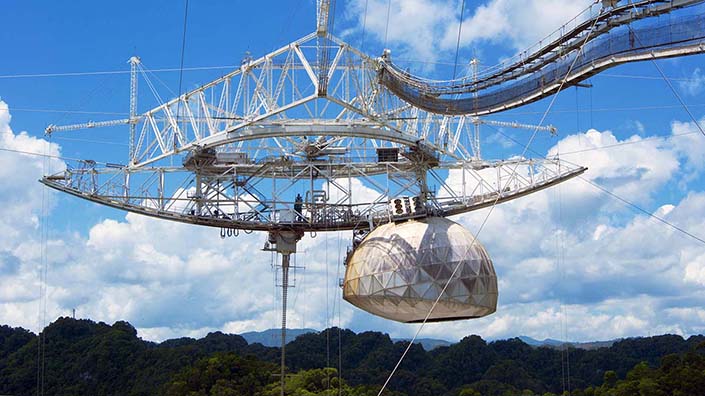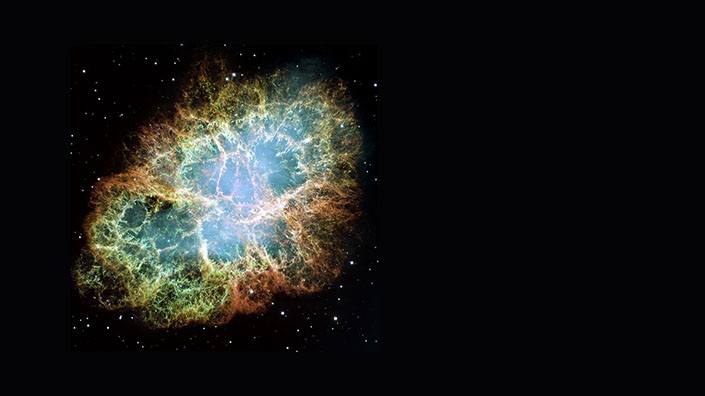Luis Quintero, head of electronics at Arecibo Observatory, is used to downpours. After all, he lives in Puerto Rico, a Caribbean island that gets the kind of tropical rain that makes umbrellas redundant. For Quintero, the incessant rain is a boon – without it, there wouldn’t have been a huge limestone sinkhole to become home to the giant radio dish that has been listening to the universe for the past half a century.
Arecibo, which opened in 1963, was until very recently the world’s largest single-aperture radio telescope. Its diameter of 305m was only superseded last year by the 500m FAST observatory in China. Hidden deep in Puerto Rico’s leafy forests, an array of antennas suspended by 18 steel cables running from three high concrete towers hangs above the giant aluminium dish, made famous by the films Contact and GoldenEye.
Considered the most sensitive radio telescope on Earth, Arecibo gathers faint radio signals from astronomical sources, and has been used to determine the rotation rate of planets and to create radar images of asteroids. Right now, it’s providing valuable data for the study of gravitational waves, and investigating the mysterious fast radio bursts.
Maintaining such sensitive equipment in the jungle is a constant struggle, and the site’s long-term future is in doubt, with its contract due to expire next March. “We have been given five choices,” said Nicholas White, senior vice-president of the Universities Space Research Association, which helps to manage Arecibo, in an interview with The Observer. “We can keep Arecibo going; find another funder; turn it into an educational facility – in other words transform it into a museum; mothball it; or demolish it.”
The observatory is a prime example of science and engineering working in close cooperation. It owes its existence to William E Gordon, a former electrical engineering professor at Cornell University in New York state who identified a natural bowl-shaped depression for the telescope in the island’s Rio Abajo Forest, 15km south of the coastal town of Arecibo.
Unknown signals
Clearly, the specification is science-led, but it is improvements in the engineering of the reflector surface and receiver electronics that make ever more accurate scientific determinations possible. “We are always looking for upgrades,” says Quintero, explaining that the original antenna surface was formed from what one scientist described as “not very accurate chicken wire”.
Since then, the antenna surface has undergone several transformations to improve the accuracy of its profile. The main upgrades took place between 1972 and 1974, when the wire was replaced with 38,778 aluminium panels, and between 1993 and 1997, which brought about the current accuracy. The dish varies by only about 2mm across its 305m diameter. As a result, the telescope’s operational range extends from 327MHz to 10GHz.
Unlike satellite TV dishes, which are paraboloids designed to bring parallel rays from a distant object to a single focus, the Arecibo antenna has a spherical reflecting surface. The spherical dish was much easier to build, but it required an extended collector, known as a line feed, to account for the spread of focus or ‘spherical aberration’. This was, effectively, a waveguide with holes along its length to collect radiation along that axis and route it to a receiver.
The problem with the line-feed design, according to Quintero, was its limited bandwidth, which meant that different feeds were required for observations in different frequency bands. That’s why, in 1997, the line feed was replaced with a Gregorian dual-reflector feed – two differently shaped reflectors that transformed the spherical dish into a paraboloid by changing how the rays come to a focus. This allowed reception across a wide range of frequencies.
 Astronomer Jill Tarter stands on the platform above the 1000-foot radio telescope in Arecibo, Puerto Rico (Credit: Roger Ressmyer/Corbis/VCG)
Astronomer Jill Tarter stands on the platform above the 1000-foot radio telescope in Arecibo, Puerto Rico (Credit: Roger Ressmyer/Corbis/VCG)
“The lion’s share of telescope time is taken by radio astronomy,” says Robert Minchin, group leader for radio astronomy at Arecibo, but other applications, primarily ionospheric research and planetary radar, account for “about 10% each”. As a result, Arecibo is renowned for correctly determining the rotation rate of Mercury (1964), discovering the periodicity of the Crab pulsar (1968) and using its radar facility to provide the first direct image of an asteroid (1989). The characterisation and mapping of near-Earth asteroids is of particular interest to the US space agency NASA, which has been tasked with cataloguing potential ‘Earth impactors’ that could destroy cities or wipe out populations.
Minchin is keen to point out that Arecibo operates an “open-skies policy,” in that anyone can propose a research topic. As with other telescopes, proposals are peer reviewed, and an advisory panel at Arecibo schedules observing time.
FRBs and gravitational waves
Hot topics addressed by Arecibo have included the discovery of exoplanets orbiting pulsars – the highly magnetised, rotating cores of collapsed stars that were first discovered 50 years ago. Minchin’s team recently “revisited the original pulsar planet,” first confirmed by Arecibo in 1992, and discovered that the orbit was far more eccentric than expected. “It threw a spanner in the theorist’s ideas, which we always love doing as observers,” he says with satisfaction.
Arecibo is also involved in the hot topic of gravitational waves, first detected by the Laser Interferometer Gravitational-Wave Observatory (LIGO) on 14 September 2015 (100 years after Einstein’s prediction of them in his general theory of relativity). With another of the world’s most sensitive radio telescopes, the Green Bank Telescope in West Virginia, Arecibo formed the North American Nanohertz Observatory for Gravitational Waves to establish, according to the NANOGrav website, “astrophysically significant limits in the search for low-frequency gravitational waves”.
Minchin explains that, in being sensitive to waves with periods of years, NANOGrav complements the work of LIGO in a different part of the gravitational wave spectrum. The NANOGrav facilities receive radio waves emitted by pulsars and use them to detect arrival-time differences that would indicate the presence of gravitational waves. So far, he says, “we have not detected anything… but a null result is not a no result”; it simply places limits on what might be detectable.
Other phenomena that have galvanised radio astronomers in recent years are fast radio bursts (FRBs), which are very brief, lasting just a few milliseconds, but extremely powerful bursts of energy received over a wide range of frequencies. The most luminous radio signals in the universe, most FRBs have been found in archived data – but the first ‘live’ burst was detected at the Parkes Observatory in Australia as recently as January 2015 .
Arecibo was the first facility to independently confirm the Parkes observation. “The particular source found at Arecibo, FRB 121102, turned out to be really special,” says Shami Chatterjee, who led the team at Cornell University that first discovered FRBs. “We needed the huge sensitivity of Arecibo to discover repeat bursts, and that enabled the localisation programme we carried out at the Very Large Array,” a group of 27 radio telescopes in New Mexico.
Speculation as to the origin of FRBs has been rife ever since their discovery, with suggestions ranging from merging black holes to signs of extra-terrestrial intelligence. What can be said about FRBs, says Minchin, is that, because the signals exhibit very high dispersion, which increases with distance, “they must be extragalactic and therefore quite bright”.
Powered by as much energy as 500 million suns, FRBs promise to hold astronomers’ interest for some time to come. “Going forward, Arecibo has immense potential as a discovery machine, both for fast radio bursts and for radio pulsars that we use as laboratories for physics and detectors for gravitational waves,” says Chatterjee.
Back on planet Earth, Luis Quintero is faced with the day-to-day challenge of keeping the observatory running. “We try to do preventative maintenance,” he says, “and we work on the antenna surface panels most days”.
In fact, ongoing maintenance, including essential testing and calibration activities, is built into the telescope’s master schedule – and takes “about 30% of the time,” says Quintero.
 The telescope's Gregorian reflector has helped astronomers search for signs of life beyond our planet (Credit: Mark Williamson)
The telescope's Gregorian reflector has helped astronomers search for signs of life beyond our planet (Credit: Mark Williamson)
A particular challenge, he adds, is “keeping the old technology working” in the hot and humid environment of Puerto Rico. High-voltage power supplies and electrical devices – such as the telescope’s motors, air conditioners and cryogenically-cooled detectors – don’t mix well with moisture, so maintaining the integrity of insulation is relevant for anything from receiver electronics to fibre-optic communications./p>
Tough environment
In fact, the dynamic temperature range has more immediate effects, simply as a result of the expansion and contraction of the cables that support the Gregorian feed dome above the dish: if the dome was allowed to move relative to the dish, it would defocus the telescope. To counteract this, a motion control system uses laser ranging techniques to control tensioning motors that maintain the position of the feed platform above the reflector, so keeping the image focused.
Another challenge, says Quintero, is minimising radio-frequency interference from “neighbours,” such as defence radars and commercial telecoms. This requires 24-hour monitoring, he explains, because “interference is a daily occurrence ”.
And on top of all this there is ‘thermal noise’ from the natural surroundings. Thermal noise is due to the intrinsic random motion of electrons and is inherent in anything warm. This is not an issue for a receiver tasked with detecting a strong signal, but astronomical telescopes are rarely involved with strong signals and need to reduce the background noise to the greatest extent possible to allow the detection of extremely weak signals. Indeed, in common with many other telescopes, Arecibo’s detectors are cryogenically cooled to avoid thermal noise from the detectors themselves interfering with the wanted signal.
“Sensitivity is a key aspect, because high sensitivity reduces integration time and means that signal-to-noise is better,” explains Quintero. Signal-to-noise is improved by collecting more signal, which is why large antennas are important for resolving faint sources./p>
Uncertain future
Unfortunately, as Arecibo’s detectors became more and more sensitive over the years with improving technology, it was found that they were picking up background thermal noise from the local, relatively warm, vegetation. The solution was to erect a 16m-tall ‘ground screen’ around the periphery of the main reflector to limit thermal noise from the surroundings.
 In 1968, Arecibo discovered the periodicity of the Crab pulsar, which sits within the Crab Nebula (Credit: NASA/ESA/JPL/Arizona State Univ.)
In 1968, Arecibo discovered the periodicity of the Crab pulsar, which sits within the Crab Nebula (Credit: NASA/ESA/JPL/Arizona State Univ.)
Although the Arecibo telescope has often been upgraded, and continues to address the newest applications from asteroid spotting to gravitational wave detection, the future of the facility remains in doubt. In early 2016, the technical media were full of scare stories. Nature warned of a “bleak future” and a lack of funding that “could soon mothball the radio telescope”.
Two-thirds of funding comes from the US National Science Foundation, with NASA providing the rest, but the observatory’s operating contract expires next March. Asked about monetary issues, Minchin admits that funding and staffing levels “could be better,” and that Arecibo is actively seeking “a longer-term funding model”. But, with an annual budget of only about $12 million, “it’s remarkably cheap for what it does,” he says .
One thing is certain: the dish is very much in demand, and its recent contributions to science and its oversubscribed observing schedule speak for themselves. Far from closing it down, Minchin believes that “we could do with a second Arecibo”.
Chatterjee says that closing the observatory is by no means a done deal, and agrees that it would be a “huge blow” to science. “Arecibo has tremendous discovery potential on FRBs, as well as an outsized impact in terms of education, outreach, and standing as a cutting-edge scientific facility in an otherwise sorely under-served area,” he says.
Billions are being spent on observing the universe at optical and X-ray wavelengths through projects such as LIGO, adds Chatterjee, but for a comparatively small amount of money “we’re potentially letting our ability to see it at radio wavelengths be downgraded. If it were to close, it would be catastrophic on many fronts.
(Lead image credit: iStock)